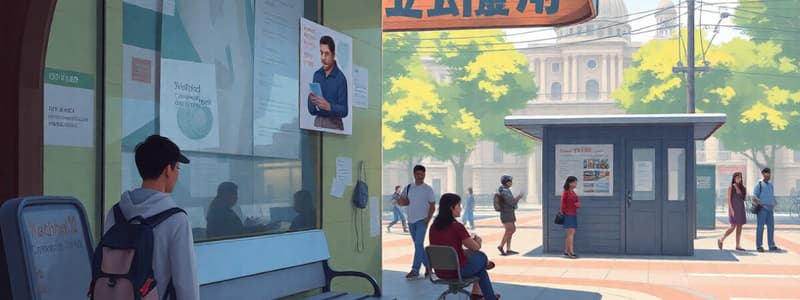Podcast
Questions and Answers
Which scenario demonstrates the most significant failure in the equitable distribution of public facilities?
Which scenario demonstrates the most significant failure in the equitable distribution of public facilities?
- A city council debates whether to allocate more funds to park maintenance or public transportation.
- A wealthy suburb enjoys a consistent water supply, while a low-income neighborhood faces chronic water shortages. (correct)
- A rural school district struggles to recruit and retain qualified teachers compared to an urban district.
- A private hospital offers advanced medical treatments not available in public hospitals.
How does the privatization of public facilities like water supply potentially conflict with the principles of a welfare state?
How does the privatization of public facilities like water supply potentially conflict with the principles of a welfare state?
- Privatization reduces the burden on the government, allowing resources to be directed to other essential services.
- Privatization introduces competition, leading to innovation and improved service quality.
- Private entities are more efficient in managing resources, leading to sustainable and reliable service delivery.
- Private companies often prioritize profit, which can result in increased costs and reduced access for vulnerable populations. (correct)
What is the most likely outcome if government-run educational institutions become significantly less important compared to private institutions?
What is the most likely outcome if government-run educational institutions become significantly less important compared to private institutions?
- Access to quality education may become more dependent on socioeconomic status, exacerbating existing inequalities. (correct)
- Innovation in teaching methods and curriculum development will accelerate.
- The government can focus on regulating educational standards rather than providing direct services.
- Overall educational standards will rise due to increased competition among institutions.
Which of the following actions would MOST effectively address the disparities in public facility access between metropolitan cities and rural villages?
Which of the following actions would MOST effectively address the disparities in public facility access between metropolitan cities and rural villages?
Why is access to public facilities considered a component of the 'Right to Life' by the Indian Constitution?
Why is access to public facilities considered a component of the 'Right to Life' by the Indian Constitution?
Flashcards
Public Facilities
Public Facilities
Services like water, healthcare, education, and transport provided by the government for the benefit of the public.
Inadequate Distribution
Inadequate Distribution
In India, the supply of public facilities is often insufficient and unequally distributed among the population.
Safe Drinking Water
Safe Drinking Water
Essential for preventing disease, and the government is responsible for ensuring everyone has access to it.
Urban vs. Rural Disparities
Urban vs. Rural Disparities
Signup and view all the flashcards
Privatization Concerns
Privatization Concerns
Signup and view all the flashcards
Study Notes
- Public facilities are services like water, healthcare, sanitation, education, public transport, and electricity provided by the government for the benefit of many
- The distribution of public facilities in India is often inadequate and unfair
Importance of Public Facilities
- Public facilities are crucial for meeting basic needs
- Public facilities are recognized by the Indian Constitution as part of the Right to Life
- Access to safe drinking water is essential for preventing water-related diseases
- The government is responsible for ensuring universal access to public facilities
- Public facilities lead to better living standards
- A country's international recognition regarding development is aided by public facilities
Disparities in Access
- In Chennai, water distribution is uneven, affecting communities differently
- Some areas receive regular water supply, while others face erratic or limited access
- The burden of water supply shortage falls mostly on the poor
- The poor cannot afford private means such as packaged water or water from tankers
Government's Role and Challenges
- The government plays a vital role in ensuring public facilities are available to everyone
- The government makes provisions for education, healthcare, sanitation, and transport
- Progress in providing public facilities is unsatisfactory
- There is inequality and irregularity in distribution of public facilities
- Towns and villages often receive a lower water supply compared to metropolitan cities
- Poorer localities are underserved compared to wealthier areas in terms of public facilities
Privatization vs. Government Management
- Privatization of essential services like water supply is rare globally
- Private companies primarily focus on profit
- Private entities may increase costs, making services unaffordable for many
- Increased cost of privatized services has led to protests and governments reclaiming control
- Government-run institutions risk becoming less important while private educational institutions are growing
- Disparities in access to quality education between the rich and the poor may arise due to privatization
Studying That Suits You
Use AI to generate personalized quizzes and flashcards to suit your learning preferences.
Description
Public facilities like water, healthcare, and education are vital services provided by the government. They are essential for meeting basic needs and are recognized as part of the Right to Life in the Indian Constitution. However, the distribution of these facilities in India is often inadequate and uneven, leading to disparities in access, as seen in Chennai's water supply.




